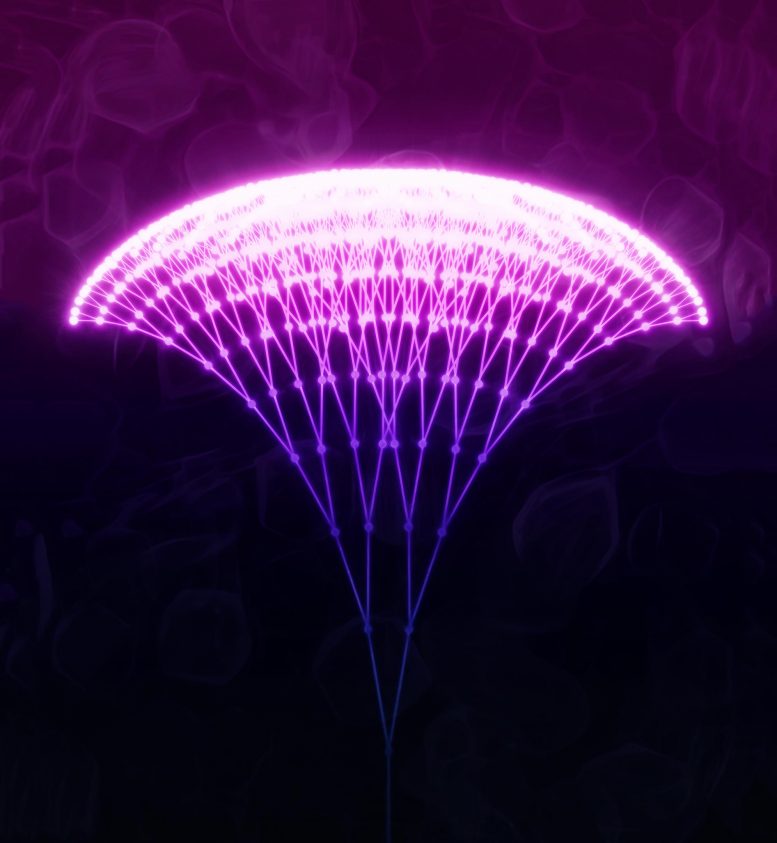
An illustration of the chain-reaction process that underlies the photon avalanching mechanism Columbia Engineering researchers have realized in their nanoparticles. In this process, the absorption of a single low-energy photon sets off a chain reaction of energy transfers and further absorption events that result in many highly excited ions within the nanoparticle, which then release their energy in the intense emission of many higher-energy photons. Credit: Mikolaj Lukaszewicz/ Polish Academy of Sciences
Researchers develop the first nanomaterial that demonstrates “photon avalanching;” finding could lead to new applications in sensing, imaging, and light detection.
Researchers at Columbia Engineering report today that they have developed the first nanomaterial that demonstrates “photon avalanching,” a process that is unrivaled in its combination of extreme nonlinear optical behavior and efficiency. The realization of photon avalanching in nanoparticle form opens up a host of sought-after applications, from real-time super-resolution optical microscopy, precise temperature and environmental sensing, and infrared light detection, to optical analog-to-digital conversion and quantum sensing.
“Nobody has seen avalanching behavior like this in nanomaterials before,” said James Schuck, associate professor of mechanical engineering, who led the study published today (January 13, 2021) by Nature. “We studied these new nanoparticles at the single-nanoparticle level, allowing us to prove that avalanching behavior can occur in nanomaterials. This exquisite sensitivity could be incredibly transformative. For instance, imagine if we could sense changes in our chemical surroundings, like variations in or the actual presence of molecular species. We might even be able to detect coronavirus and other diseases.”
Avalanching processes — where a cascade of events is triggered by series of small perturbations — are found in a wide range of phenomena beyond snow slides, including the popping of champagne bubbles, nuclear explosions, lasing, neuronal networking, and even financial crises. Avalanching is an extreme example of a nonlinear process, in which a change in input or excitation leads to a disproportionate — often disproportionately large — change in output signal. Large volumes of material are usually required for the efficient generation of nonlinear optical signals, and this had also been the case for photon avalanching, until now.
In optics, photon avalanching is the process where the absorption within a crystal of a single photon results in the emission of many. Researchers have used photon avalanching in specialized lasers, where the photon absorption sets off a chain reaction of optical events that ultimately lead to efficient lasing.
Of particular note to researchers is that the absorption of just a single photon leads not only to a large number of emitted photons but also to a surprising property: the emitted photons are “upconverted,” each one higher in energy (bluer in color) than the single absorbed photon. Scientists can use wavelengths in the infrared region of the optical spectrum to create large amounts of higher-energy photons that are much better at inducing desired chemical changes — such as killing cancer cells — at targeted locations deep within tissue, wherever the avalanching nanoparticles are positioned.
Photon avalanching (PA) behavior drew significant interest more than 40 years ago when researchers recognized that its extreme nonlinearity could broadly impact numerous technologies, from efficient upconverting lasers to photonics, optical sensors, and night vision devices. PA behavior is similar to that of a transistor in electronics, where a small change in an input voltage results in a large change in output current, providing the amplification necessary for the operation of nearly all electronic devices. PA enables certain materials to function essentially as optical transistors.
PA has almost exclusively been studied in lanthanide (Ln) based materials due to their unique optical properties that allow them to store optical energy for relatively long amounts of time. However, achieving PA in Ln systems has been difficult — it requires cooperative interactions between many Ln ions while also moderating loss pathways, and has thus been limited to bulk materials and aggregates, often at low temperatures.
These limitations have relegated the fundamental study and use of PA to a niche role in photonic science, and have led researchers to focus almost exclusively over the past decade on other upconversion mechanisms in materials development, despite the unrivaled advantages offered by PA.
In this new study, Schuck and his international team of collaborators, including the groups of Bruce Cohen and Emory Chan (The Molecular Foundry, Lawrence Berkeley National Lab), Artur Bednarkiewicz (Polish Academy of Sciences), and Yung Doug Suh (Korea Research Institute of Chemical Technology and Sungkyunkwan University), showed that by implementing some key nanoparticle design innovations such as select lanthanide contents and species, they could successfully synthesize novel 20nm nanocrystals that demonstrate photon avalanching and its extreme nonlinearity.
The team observed that the nonlinear optical response in these avalanching nanoparticles scales as the 26th power of the incident light intensity — a 10% change in incident light causes more than a 1000% change in emitted light. This nonlinearity far exceeds responses reported previously in lanthanide nanocrystals. This extraordinary response means the avalanching nanoparticles (ANPs) show great promise as sensors, since a small change in the local environment can lead to the particles emitting 100-10,000 times more brightly. The researchers also found that this giant nonlinear response in ANPs enables deeply sub-wavelength optical imaging (with the ANPs used as luminescent probes, or contrast agents), using only simple scanning confocal microscopy.
“The ANPs allow us to beat the resolution diffraction limit for optical microscopy by a significant margin, and they do it essentially for free, due to their steeply nonlinear behavior,” Schuck explains.
The study’s lead author Changhwan Lee, who is a PhD student in Schuck’s group, adds, “The extreme nonlinearity in a single ANP transforms a conventional confocal microscope into the newest superresolution imaging system.”
Schuck and his team are now working on how to use this unprecedented nonlinear behavior for sensing changes in the environment, such as fluctuations in temperature, pressure, and humidity, with a sensitivity that has not yet been achievable.
“We are very excited about our findings,” says Schuck. “We expect them to lead to all kinds of revolutionary new applications in sensing, imaging, and light detection. They may also prove critical in future optical information processing chips, with ANPs providing the amplifier-like response and small spatial footprint typical of a single transistor in an electronics circuit.”
Reference: “Giant nonlinear optical responses from photon avalanching nanoparticles” Changhwan Lee, Emma Xu, Yawei Liu, Ayelet Teitelboim, Kaiyuan Yao, Angel Fernandez-Bravo, Agata Kotulska, Sang Hwan Nam, Yung Doug Suh, Artur Bednarkiewicz, Bruce E. Cohen, Emory M. Chan and P. James Schuck, 13 January 2021, Nature.
DOI: 10.1038/s41586-020-03092-9
Authors are: Changhwan Lee1, Emma Xu1, Yawei Liu2,3, Ayelet Teitelboim2, Kaiyuan Yao1, Angel Fernandez-Bravo2, Agata Kotulska4, Sang Hwan Nam5, Yung Doug Suh5,6, Artur Bednarkiewicz4, Bruce E. Cohen2,7, Emory M. Chan2, and P. James Schuck1
1 Department of Mechanical Engineering, Columbia Engineering
2 The Molecular Foundry, Lawrence Berkeley National Laboratory
3 State Key Laboratory of Rare Earth Resource Utilization, Changchun Institute of Applied Chemistry, Chinese Academy of Sciences
4 Institute of Low Temperature and Structure Research, Polish Academy of Sciences
5 Laboratory for Advanced Molecular Probing, Korea Research Institute of Chemical Technology
6 School of Chemical Engineering, Sungkyunkwan University, South Korea.
7 Division of Molecular Biophysics & Integrated Bioimaging, Lawrence Berkeley National Laboratory
The study was supported by the Global Research Laboratory Program through the National Research Foundation of Korea funded by the Ministry of Science and ICT (no. 2016911815). Support was also provided by Programmable Quantum Materials, an Energy Frontier Research Center at Columbia University funded by the U.S. Department of Energy (DOE), Office of Science, Basic Energy Sciences (BES), under award DE-SC0019443. Work at the Molecular Foundry was supported by the Office of Science, Office of Basic Energy Sciences, of the U.S. Department of Energy under Contract No. DE-AC02-05CH11231.









Focus back into single beam and restart the process, and so on and so forth… Just sayin 😉 you’ll thank me later
Am avalanche that’s 10,000 times more brightness from a single photon, and they’re higher-frequency (thus higher-) energy-) photons too! This is an obvious violation of conservation of energy…
It seems that before photon avalanching can happen, first the ions must be excited twice with a ground state absorption and then an energy state absorption; I think you do this “priming” by shining higher-energy light on the nanoparticles, which takes energy. I wish the press releases from the laboratories had explained this!
It seems to me that this technology could be used to enable PV cells to convert infrared energy into visible light for conversion to electricity.
Obvious violation of conservation of energy. Energy can neither be created nor destroyed. Only converted from one form to another with a percentage always becoming heat.
Therefore there is something this report is not stating. Whether the nano particles are primed first with energy to be later converted to photons. Or else the nano particles themselves break down and in breaking down release energy as light. Which changes things drastically
This post is very important information. I have learning more. I really enjoyed its reading this post enough to search for writing this excellent article and helpful post thanks for sharing.